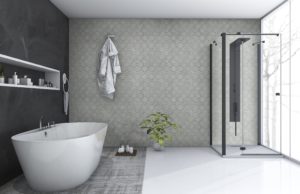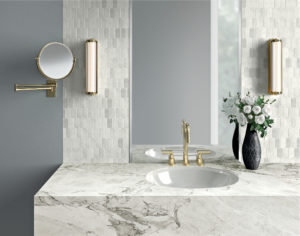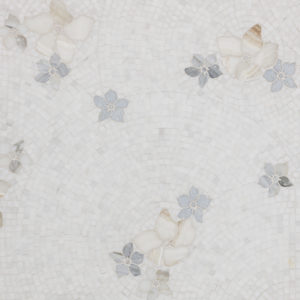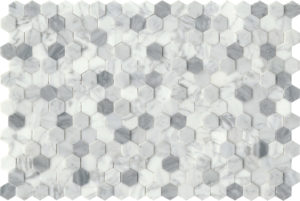By Megan Salzano

Industry has had its fair share of hardship this year, and flooring is no exception. The onset of the COVID-19 pandemic brought with it a startling halt to progress in the spring; however, as time progressed, stay-at-home orders and other safety measures have proven that home is more than where the heart is. Home has become a safe haven for consumers across the U.S., and many have begun rebuilding and renovating their residences in preparation for continued nesting. The flooring industry in general, and the natural stone category in particular, is starting to reap the benefits of such activities.
Today, as it has been for centuries, natural stone represents the epitome of luxurious design and the benchmark for durability and one-of-a-kind aesthetics. As such, consumers seeking to not only upgrade their homes for comfort and utility but also infuse resale value are looking to the category when making these at-home tuneups.
“Although COVID-19 initially slowed sales of natural stone, we have seen a sudden uptick as a result of the renewed focus on home improvement,” explained Raj Shah, president, MSI Surfaces. “Of all surfacing types, natural stone also has the ability to increase resale value of a home due to its classic aesthetics. This has brought additional focus to the category in recent months. Our belief is the category may be up by as much as 3%-5% in recent months.”
Residential stone continues to do well for other reasons, too. Mara Heras, vice president of marketing, Emser, noted emphasis continues to grow for sustainable materials, and homeowners are looking to replace inorganic materials with more natural stone products for both residential and commercial applications. In addition, she said how consumers are utilizing the material continues to make its mark—expansion to the outdoor, more wall applications and wet areas are key drivers.
For these reasons, Heras said Emser agrees the overall ceramic tile and stone industry continues to grow at a low single-digit pace.
Where opportunity lies

For natural stone, opportunity remains firmly entrenched in the kitchen and bath. According to suppliers, these two areas of the home are where consumers see the best bang for their buck and are willing to invest heavily in order to gain valuable returns and also create a sense of luxury. “There are opportunities in both countertops and flooring for natural stone in kitchens and master bathrooms,” explained Roy Viana, director natural stone and slab, Dal-Tile Corporation. “Kitchen countertops and islands are a place to make a unique, very personal statement—which can be done with natural stones like granites and natural quartzites. Customers are willing to invest significant money in these areas to create luxurious focal points.”
Natural stone’s inherent features also make it an ideal choice for these locations. “Many stone products feature slip-, stain- and water-resistant properties so they are well suited to areas including kitchens, bathrooms, showers and pool surrounds,” Emser’s Heras said. “Kitchens and bathrooms continue to be the highest opportunity for stone and are areas where homeowners often splurge on unique and highly decorative looks. Tile and stone are an ideal surface for these spaces as they can provide a waterproof installation with designs ranging from beautifully simple to intricate and striking.”
While a move outdoors had already begun, suppliers said the pandemic has increased the necessity for expanding “usable living space” to the outdoors. “Today, we are seeing significant growth in the outdoor use of stone,” MSI’s Shah said. “The outdoor category is probably the strongest segment in the industry due to the pandemic. Stone has so many outdoor options, including pavers, pebbles, facades, firepits and BBQ countertops. In addition, vertical applications for natural stone are disproportionately growing. Stacked stone is one of the highest growing surfacing categories.”
In addition, the availability of larger formats has driven more interest in utilizing tile in living spaces such as great rooms, open concept homes and living rooms, in addition to locations such as fireplace surrounds.
Of the move toward fireplaces, Roy Marcus, brand ambassador, Artistic Tile noted, “The changing nature of [the fireplace], as gas-powered installations replace wood-burning, chimneyed fireplaces, has also changed the way that stone can be specified for them. The discreet and refined footprint of the flame element in new systems offers the option of slab stone as a backdrop, to exceptionally stylish effect. Entire walls of book-matched slab and walls of sculpted stone tile and slab have become signatures of the work of top designers and architects in luxury residential.”
Within the natural stone category, several material types have proven their worth over the years. For most, marble and limestone continue to drive sales. “Marbles and limestone are the two most popular stones in the industry,” Dal-Tile’s Viana said. “These two stones will continue to take market share as long as a contemporary color palette is offered.”
When it comes to the draw of limestone, Viana said its wide spectrum of natural colorways is an enticing allure. “With distinctive flecks and granular patterns, it can add an instant touch of elegance to any room. For example, a limestone floor can transform a simple bathroom into a luxurious, contemporary at-home spa.”
Marble is the best well-known of the natural stones and most highly sought after by discerning consumers. “White and gray marbles are still trending, and manufacturers are creating new unique products in different shapes and sizes that provide fresh looks,” Emser’s Heras said. ‘However, the desire for warm colors and texture bring travertine and slates as well as warmer marble into the mix as well.”
Challenges remain
While natural stone will most likely remain a coveted building material for the foreseeable future, challenges are inescapable—this year, even more so.
The impact of the coronavirus pandemic is still being felt across the country and around the world, and while a surge home building and renovation is good news, there have been negative impacts to the category and business overall as well.
“In the short term, the pandemic has changed many aspects of how businesses operate and how consumers select and buy natural stone,” Viana explained. “Online searching/shopping has accelerated dramatically. A broadened sampling focus is also key to assisting customers with their natural stone selections during this time.”
A newer, and hopefully short-lived, challenge in new construction and remodeling today, according to Emser’s Heras, is the shortage of materials. “COVID-19 has affected the supply chain for some, both in stone and in other categories,” explained. “Some companies are struggling with maintaining the inventory to meet this heavy demand. While this may provide an advantage for those who are able support the market needs, shortages in other categories can delay projects. We are seeing struggles in appliances, plumbing fixtures and other categories are delaying sales in flooring as builders and remodelers are slowed in construction.”
When it comes to challenges within the category itself, suppliers agree consumers have become bogged down by aesthetics and technical specifications. “The largest challenge to the category continues to be the natural variation and inspiring consumers with the beauty that can be achieved with natural stone,” MSI’s Shah noted. “In addition, natural stone has received a lot of bad publicity on its technical capabilities when it comes to staining and long-term customer satisfaction. We have to remember that natural stone has been used as a building material for thousands of years. Its classic look will never go out of style and enables homeowners to worry less about changes in trends. Retailers can continue to help consumers by educating them on the actual capabilities of natural stone. It is the original waterproof surface.”
Related to the issue of aesthetics, competition from adjacent categories like porcelain and ceramic tile and even from that of LVT also remain a challenge for the category. “The misconception that visually imitative porcelains can replace the variety and appeal of natural stone has duped many a client,” Artistic Tile’s Marcus said. “A properly installed natural stone floor—or wall or counter—will perform for multiple decades before replacement needs to be pondered. Ultimately, man-made products cannot match the intrinsic beauty and nuance of natural stone.”
Dal-Tile’s Viana agreed, noting the competition but also the opportunity. “Innovative technologies in the ceramic and LVT categories are allowing the creation of very realistic stone visuals at a fraction of the cost of natural stone. These hard surface categories are making a dent in the stone industry. However, ceramic and LVT products are generally used in floor applications, leaving a big opportunity for the installation of natural stone in vertical settings.”
But perhaps the biggest challenge to the category—and one that lingers throughout the industry—is that of training and installation. Suppliers say that not only is a diminishing labor pool impacting the ability of natural stone to be installed well, but steadily increasing installation prices on an already expensive category. In addition, consumers need to be properly educated by well-trained RSAs on the features of natural stone to ensure satisfaction.
“The education and touch points required make it a longer and more involved sale,” Emser’s Heras explained. “That said, the result is usually higher margin, more satisfied customers and a more stunning environment. We expect that retailers who are diversified beyond residential home remodel (commercial, builder and trade businesses) are the ones who will succeed in stone.”
Innovation and trends

While it may seem unlikely for innovation to influence time-old materials, natural stone suppliers say improvements touch the category often. Waterjet cutting, for example, is an innovation that has left its mark on the category but has grown even more advanced in recent years.
From the manufacturing perspective, Artistic Tile’s Marcus said stone suppliers are able to be more flexible in creating shapes, sizes and designs as advancing waterjet cutting allows for more intricacies. “We have brought that technology into new arenas, using it to add very special visual allure to our new Getozzo tile, where waterjet cut pieces of marble are placed into water-jetted ground of terrazzo, or our Sakura, in which water-jetted cherry blossoms are added to a circular pool made of the kind of tesserae marble chips the ancient Romans would have known.”
Design trends also help shape innovation, and suppliers agree texture, dimensionality and color are all driving innovation. “Texture and 3D dimensionality in stone are not recent innovations; however, new technologies are allowing creation of different visuals on the surface of stone, at a more affordable cost,” Daltile’s Viana said. “The visuals, finishes and textures that are now achieved with new machineries are setting stone apart from other floor and wall covering categories.”
Daltile’s Center City is one example. The line is a collection of natural limestone and marble offering neutral colors, contemporary sizes and popular shapes. Three large-format sizes, including a plank, and a linear mosaic gives this collection a mix-and-match, modular capability.

Emser’s Heras agreed that advances in technology have led to new finishes, dimensional cuts, larger formats and more, including groutless stone mosaics. “Grout-less mosaics help with installation,” she explained. “New technologies, such as grout-less stone mosaics, are making installation a breeze and provides new looks for backsplashes, fireplace facades and wall accents.”
Emser Tile’s Link is a grout-less marble mosaic that provides a unique three-dimensional design and is available in multiple patterns.
Color also continues to be a driver. For natural stone, neutral colorways including whites and grays continue to reign. “We are still seeing a strong push and love for white marbles,” said Emily Holle, director of trend and design, MSI. “All of them—white and gray veining, white and gold veining and simplistic solid whites. The main driver of this is that they are style neutral, they fit into a variety of looks from classic to ultra-modern.”
